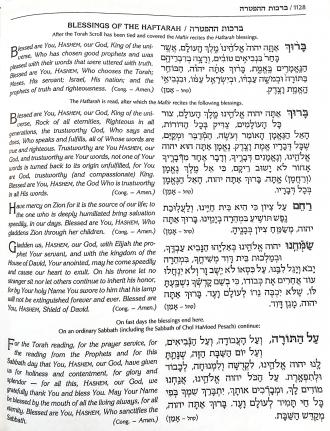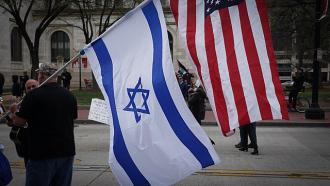ויהי ביום כלות משה להקים את המשכן (במדבר ז א), It was on the day that Moshe finished erecting the Tabernacle...
The word used to indicate ‘finishing’, כַּלוֹת, is similar to the word we use for a bride, כַּלָה, teaching us that on the day the Tabernacle was erected the Jewish nation was like a bride entering under the חופה, a bridal canopy. (רשי בשם התנחומא)
This notion of our marriage to G-d was first expressed at Mount Sinai where the Torah describes how, ויוצא משה את העם לקראת האל-הים (שמות יט יז), Moshe brought forth the people from the camp toward G-d, implying that the שכינה, the Divine Presence, came out toward them like a bridegroom greeting his bride. (רש"י בשם המכילתא)
Nachmanides reiterates in several places that the Tabernacle was a replica of the experience at Mount Sinai, where we come under the canopy of the Divine Presence.
Rav Samson ben Zadok, the devoted disciple of the famed 13th century rabbinic figure and Tosafist, Rav Meir of Rottenberg, (the Maharam), in his seminal work, Tashbatz, records in the name of his famed teacher that many of the traditions associated with the marriage ceremony are patterned on the marriage between G-d and His nation at Mount Sinai. The etching of G-d’s words onto the Two Tablets is reminiscent of the Kesuba, the marriage contract. The ten men required to be in attendance at the blessings under the canopy correspond to the Ten Commandments. The candles remind us of the lightning and fire that was present during the revelation at Sinai. The very expression a groom says to his bride: הרי את מקודשת לי (בטבעת זו) כדת משה וישראל, Behold you are consecrated unto me (with this ring) in accordance with the law of Moshe and [the People of] Israel, accentuates this parallel between the union of every Jewish couple and our nation’s ‘marriage’ to G-d at Mount Sinai. (תשב"ץ אות תסד-תסה)
Others suggest that the חופה, the bridal canopy, is modeled after Mount Sinai itself that G-d ‘suspended over them like an inverted basin’ that served as the bridal canopy for His marriage to His beloved nation. (שיטה מקובצת בשם גליון תוס' כתובות ז:)
So at Mount Sinai we had a bride and groom, a marriage contract, a bridal canopy, and candles.
But where is the ring? This most vital component, the object that effect the betrothal is missing!
•
In a small town somewhere in Eastern Europe a young girl lived a happy existence. Her brother caught fish from the local pond for Shabbos. Her father, a merchant, traveled far and wide providing for his family, bringing home not only his earnings but small magical gifts from distance places for his children who so longed for his return. The house filled each Friday with the sweet aroma of Challah and the special scent called ‘Shabbos’.
But then the world turned upside down. Jews would be isolated in ghettos, nevertheless opening their hearts and homes to make room for refugees seeking shelter, sharing generously whatever meager offerings they could scrape together.
With her Aryan looks she would be ‘safely’ dispatched by her father beyond the confines of the ghetto to stealthily barter whatever contraband they still had that could be bartered so that they might survive another day.
Feigning sleep on the train to avoid conversation with her fellow travelers lest her identity be discovered, her mind focused on the challah she would soon bake for Shabbos with her mother upon her safe return. She quietly removed a gold ring she had received as a gift from a beloved friend from her finger in anticipation of her kneading the dough and placed it in her travel bag together with the day’s earnings.
Rushing home and after breathing a deep sigh of relief she eagerly went to work preparing the dough. A bit later when her father asked for the profits of her day’s efforts she discovered her bag was nowhere to be found. She inquired high and low from the many ‘guests’ who they sheltered if they had seen her bag, suddenly remembering that her ring she had placed in it was now missing too, painfully blurting out, “where is my ring?” She began to suspect one of the strangers. Her father sensing her suspicion gently admonished her to never cast any doubt on a fellow Jew. She acquiesced, but couldn’t get over the loss of her cherished ring that was her last connection to the warm memories of her past.
Soon the pain over the loss of a piece of jewelry paled in significance as she now feared for her very life. The deportations, selections and crematoria left her orphaned from her brothers, sisters and parents, facing grueling living and working conditions and wondering whether she could ever physically survive this incomprehensible hell. She longed for the day when she could begin to build her life anew.
After liberation, she found herself on a boat together with other very fortunate survivors, heading to the Promised Land, Eretz Yisroel. One of her friends introduced her to an eligible young man who had gone through similar upheaval. They took to each other and right there on the boat they announced their engagement. Shortly thereafter upon reaching the shores of Israel she stood under the chuppa as her new husband presented her a ring accompanied by the comforting words of ‘Harei at mekudeshes li b’tabaas zu k’das Moshe v’Yisroel.
One can only imagine the heightened emotions of the moment. Aware of the tradition that the ancestors’ souls are present at a simcha, she sensed the strong bonds of love from her parents and siblings that had strengthened her through so many difficult days now rejoicing with her as she headed towards rebuilding their legacy.
She glanced lovingly at the ring and suddenly gasped. It was the exact ring that she had lost many years back in those trying times. She excitedly turned to her groom curious to discover how he came upon it.
He retold how during a food distribution one day in his concentration camp they served an excuse for soup laced with thin strands of meat barely floating in it. Although the circumstances of the time permitted the eating of ‘treif’, since their very lives were always precariously hanging by a thread, nevertheless he had made a personal commitment never to eat treif, non-kosher, even at near risk to life. He desperately sought out someone who might be willing to exchange their ration of stale bread for this measly offering. As there was no bread to be had he forfeited his portion, offering the soup to the first taker. One of the inmates came forward to accept it, but with a remnant of self-dignity that he managed to preserve amidst so much inhumanity, he insisted that he give in exchange a gold ring that was still in his possession. The groom conveyed how after accepting the ring he held tightly onto it throughout his entire internment letting it serve as his personal symbol of hope in the despairing darkness of that terrible place, that he would one day yet merit to marry and establish a family.
Not only did he realize his own dream but little did he know that he would be fulfilling the mitzva of returning a lost object to its rightful owner as well!
•
A ring is an object that completely surrounds the bride’s finger. It may be worth barely a perutah, the minimum amount necessary to effect a transaction, but it serves for the bride as an eternal reminder of the groom’s protective love and commitment to always be there for his beloved. (ספר החינוך מצוה תקנב)
G-d constantly ‘surrounds’ us with His presence. He is attentive, devoted, loving and guiding.
The Sefer Tanya discusses the concept of the Ohr Makif, a transcendent encompassing light that frames our reality. These are the supra-natural, supra-rational manifestations of divine light. We call these miracles, existential mysteries, and mind-blowing experiences; we cannot understand them or assimilate them, only accept them and submit to them. This is not to say that the encompassing light is something that is outside of our being. In the words of the Tanya, ‘it penetrates our reality from head to foot, to its innerness and the inside of its innerness’. Even as it suffuses our being, it remains aloof from us and beyond us, holding us in its embrace while eluding our attempts to grasp it and define it.
The Torah describes how G-d discovers His people ‘in a desert land, in desolation, a howling wilderness; יסבבנהו, He encircled them, יבוננהו, He granted them understanding, יצרנהו כאישון עינו, He preserved them like the pupil oh His eye.
Rashi quoting the Sifrei teaches us that this ‘encircling’ refers to His having surrounded them beneath Mount Sinai as an inverted tub, our bridal canopy. Alternately, he says, it refers to the Clouds of Glory that protectively encompassed them.
The ‘missing ring’ may not readily be visible, but it is always there.
The Ohr Makif is the proverbial ring that represents His devotion and commitment to, and protection of, His beloved bride, the Jewish nation, that effect for all of eternity his betrothal to them.
My dear friend Rav Dani Kermaier suggests that the verse in Hoshea that describes G-d betrothing His beloved nation indicates this as well.
וארשתיך לי באמונה וידעת את ה' (הושע ב כב), I will betroth you to Me with fidelity, and you shall know G-d.
It is precisely that faithfulness that is the all-encompassing ring of marriage that G-d offers his bride.
May I add that the emphasis we place on the ring when we state “Behold you are consecrated unto me, בטבעת זו, ‘with this ring’..., is numerically equivalent to the very next expression that follows in this verse: וידעת, and you shall know, the very essence of what the ring represents: an awareness of His encircling us fully with His embrace.
( בטבעת זו = 496 / וידעת = 490 + its 5 letters + 1 for the entire word itself (הכולל) = 496)
•
The young survivor never lost that most valuable of rings, the sense of the all-encompassing Ohr Makif, the marriage band we carry each moment of our lives, that instills within us the faith that the ultimate groom, the Almighty, will protect, provide, and rescue us from our plight.
She felt it each time she arrived safely home from her missions. She sensed it when she accepted her father’s lesson in generosity towards others. She perceived it, oh so clearly, when her groom presented her with the ring he received in reward for his placing himself within G-d’s protective embrace, unwilling to compromise His will, even under the most trying of circumstances.
She knew as she stared at her beloved ring, that brought her a rush of warm memories of times past, that He would be there for her, forever tending lovingly to His most cherished bride.
•
May we always be cognizant of our marriage to G-d, remaining faithful and dutiful, peering through the clouds of darkness that often obscure our vision to see and cherish the reality of His protective ‘ring’ that is always there in loving devotion and guidance.
באהבה,
צבי טייכמאן

















